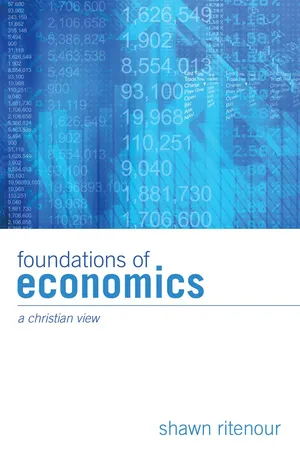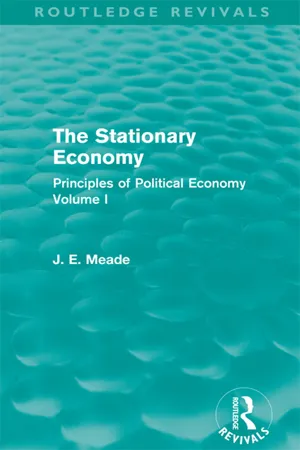Economics
Factor Prices
Factor prices refer to the payments made to the factors of production, such as labor, capital, land, and entrepreneurship, in return for their contribution to the production process. These payments include wages for labor, interest for capital, rent for land, and profit for entrepreneurship. Factor prices play a crucial role in determining the cost of production and influencing resource allocation in an economy.
Written by Perlego with AI-assistance
Related key terms
4 Key excerpts on "Factor Prices"
- eBook - ePub
Economic Lessons from the Transition: The Basic Theory Re-examined
The Basic Theory Re-examined
- Daniel R. Kazmer, Michele Konrad(Authors)
- 2016(Publication Date)
- Routledge(Publisher)
3 The Factors of ProductionHow Incomes Are Determined
Factors are the inputs into the production process. Traditionally, theory deals with three general categories. Land—including timber, fisheries, and other natural resources—earns rents. Labor earns wages. Capital—meaning here plant and equipment, not money—earns profits. These factors combine to make every product and service sold on the market.But how much are these factors worth, and who or what determines the income paid to the factor owners? Historically, this question has been answered both by political theory (capitalism, Marxism-Leninism, socialism) and by economic theory. We will first discuss economic theory, although the political theory relating to factor incomes is also interesting and important.Economic theory has developed an elegant and optimal determination of factor incomes, the theory of perfect competition. It applies the same marginal optimizing rules to factor markets that it applies to product markets.As in product markets, each factor will be paid the contribution of its marginal product to marginal revenue. Thus, if the last worker hired adds one-tenth of a widget per hour to total output and that last widget sold adds 10 euro to total revenue, then all workers will be paid the value of their marginal revenue product or 10 euro X 1/10 widgets = 1 euro/hour.Economic theory then proves that a competitive economy will make optimal use of its factors, from inputs to production, since each factor will move to the productive activity at which it is paid the most, that is, where the value of its marginal revenue product is highest. They will stop moving and be at equilibrium when the values of all their marginal revenue products are equal—when output can no longer be increased by moving inputs around. - eBook - ePub
Foundations of Economics
A Christian View
- Ritenour(Author)
- 2010(Publication Date)
- Wipf and Stock(Publisher)
On the other hand, if the price producers tried to pay was below the market clearing price, there would be excess demand for the factor. The quantity of the factor demanded by the producers would be greater than the quantity supplied by the factor owners. This would result in some frustrated producers because they would be willing to buy the services of the factor at the prevailing price, but factor owners would not be willing to sell enough to meet demand. In order to ensure that they are able to obtain the services of the factors of production that they desire, the more eager producers would bid up the price of the factor until everyone who wants to buy can buy. In the market for every factor of production, the price that clears the market prevails.Changes in Prices for Factors of ProductionJust as changes in the supply of and demand for consumer goods will yield different market prices for those goods, changes in the value scales of buyers and sellers of factors of production will result in different market clearing prices for those producer goods. In an earlier chapter we identified a long list of factors that could lead to changes in the price of consumer goods.Because of the nature of factor markets, we can simplify the analysis and focus on four things that result in changes in the market price of producer goods. The market price for factors is determined by demanders and suppliers. Therefore a change in the price of a factor of production will be the result in a change in demand or supply. Three determinants of the demand for factors of production have already been identified: the marginal productivity of the factor, the price of the good produced, and social time preference. If any of these three factors change, there will be a change in the factor’s DMRP, its demand schedule, and hence, its market price.The marginal productivity of factors is determined by technology and the quantity of complementary factors. A complementary factor is a factor that is used in conjunction with others to produce a particular good. A hot dog bun, frankfurter, ketchup, mustard, warmer, electricity, labor, and land are all complementary factors assisting the production of the consumer good: a ready-to-eat hot dog. Likewise, a farmer uses seed as well as fertilizer and land to grow a crop.If a producer increases her stock of complementary factors, the productivity of the factor used with them will tend to increase. If for example, Cecily buys more fabric and hires more labor, she can produce more shirts with every sewing machine she rents. An increase in her use of goods that are complementary to the sewing machine increases the MPP for every unit of the machines. Because every sewing machine can produce more shirts, more revenue is attributed to each machine, increasing the MRP for every unit of sewing machine. Because the MRP for every sewing machine increases, the DMRP for every unit increases as shown in figure - eBook - ePub
Microeconomics
A Global Text
- Judy Whitehead(Author)
- 2014(Publication Date)
- Routledge(Publisher)
derived demand .Studying the nature of the demand for and supply of factors of production is important at all levels of production and consumption from a small domestic protected market to the large global market. This is particularly so for the increasingly mobile factors in a globalized world, factors such as international capital and entrepreneurship. The study of the factor market provides an understanding of how the structure of the market affects the demand for factors and, particularly in the case of labour, how income and preferences for leisure/work affect factor supply.14.1.2 Classical vs. modern distribution theory
In the nineteenth century, it was customary for economists to classify productive inputs into three basic categories, namely land, labour and capital. The theory of input pricing for the classicists was therefore a theory of the distribution of income among land owners, wage earners and the owners of capital (capitalists), three economic and social factor supplying classes. Rent, wages and profit were the returns to the three factors respectively. A fourth factor, entrepreneurship, was later introduced.The marginal productivity theory
The modern theory is more general. It takes into account all types of factor inputs and how they receive their remuneration. This is the counterpart to the modern theory of value which was the focus of the earlier chapters. The modern theory is mainly marginalist in nature. Consequently, the modern distribution theory has been given the title of the Marginal Productivity theory - eBook - ePub
The Stationary Economy (Routledge Revivals)
Principles of Political Economy Volume I
- James E. Meade(Author)
- 2013(Publication Date)
- Routledge(Publisher)
In this case all other Factor Prices might rise. But this is not necessarily so because among these other factors there might be one which was a particularly close substitute for L and the price of such a factor might fall in sympathy with the price of L; but this would mean that the other Factor Prices rose all the more. In the case in which all Factor Prices without exception fell it is very probable that all product prices would also fall. If every process produced only a single product, this would necessarily be so. For since the cost of every factor was lower, the cost of producing every product would be lower; and in the new equilibrium, therefore, since prices must equal costs, every product price would be lower. 1 But in the case in which the absorption of L into the economy is difficult and large changes in relative prices are necessary it is quite probable that some product prices will actually rise. For example, in the case in which the prices of some factors go up absolutely there may well be a rise in the costs and so in the prices of those products which rely for their production particularly on these more expensive factors. If labour and land were the only two factors in the economy and if an increased supply of labour could be absorbed into the economy only if the wage rate fell very sharply, a smaller proportion of the constant money national income would go to wages and a higher to rents
Index pages curate the most relevant extracts from our library of academic textbooks. They’ve been created using an in-house natural language model (NLM), each adding context and meaning to key research topics.



